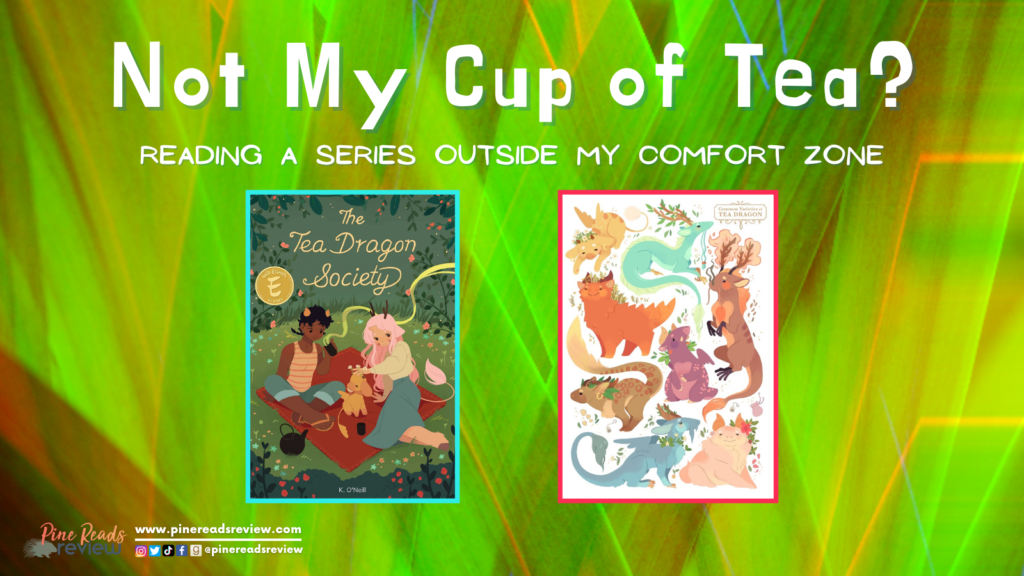
My reading habits have remained the same since I was an angsty teen – YA novels with real-world problems, love, mature themes, and female protagonists have always been my bread and butter. The most I’ve ever strayed from this formula was the vampire romance craze of the 2000s á la The Twilight Saga and The House of Night series. (And, that’s not saying much because they only strayed in terms of fantasy elements!) So, lately, as the midsummer days have turned stagnant, I figured it’d be the perfect opportunity to explore new horizons – and this has brought something to fruition: a challenge. I decided to stray from my long-lived comfort zone and read a new series to see if it might just be my cup of tea.
After putting some feelers out with the Pine Reads Team for new reading recommendations, I landed on The Tea Dragon Society series written and illustrated by Kay O’Neill. This middle grade series of graphic novels centers the art of caring for Tea Dragons – finicky, domesticated dragons that grow herbs, fruits, and flowers from the crown of their heads. In its three installments, Greta, Hesekiel, Erik, Minette, Rinn, and Aedhan share the history of Tea Dragon care and allow readers to witness how the practice shapes their lives. Everything from the aesthetic of the work to its representation and tone are thoughtfully conjured to culminate in a truly immersive reading experience.
The illustrations were what drew me to this series upon first look. O’Neill seamlessly blends deep neutrals with bright pastels in their color palette for this series. Their use of sturdy color blocking contrasts with flowing brush strokes to evoke movement and texture within their work. To further enhance the subject matter, the art style is truly a kitchen witch, cottagecore dreamscape. Delicate flowers, leaves, breezy garments, fantastic horns, antlers, and hooves adorn these kitschy characters while woodsy fairytale elements surround them. The form of this series is unlike any of my past reads. I typically favor prose or verse, but these books provided a different experience that couldn’t have been achieved otherwise. These graphic novels encourage the reader to slow down, and savor the content through the open concept of sequencing. Instead of each page being compact and filled to its margins (which I often find overstimulating), O’Neill allows each frame of the story to breathe and take up the space it needs.
And this series somehow only continued to exceed my expectations! One of the biggest strengths of The Tea Dragon Society is its commitment to enthusiastic and diverse representation. This series features representation and intersectionality in terms of disability, mental health, race, religion, gender, sexuality, language, and body neutrality. The visual nature of graphic novels makes this visibility all the more effective. A majority of the characters within this series are Black and Brown, queer, non-binary folks – and perhaps most remarkably, their identities don’t serve as fuel for narrative conflict. The casual nature of this representation felt ultimately comforting. As someone who’s used to reading books about hardship faced because of identity, it was a privilege to come up for air with this series. As important as it is to have literature which reveals oppression behind the curtain of ignorance, it’s equally as important to have literature that represents happy marginalized folks existing safely and proudly.
Still, to be completely candid, I was worried a lighter story wouldn’t impact or relate to me like ones with heavier themes often do, but I have to say – I’m glad to be so incredibly wrong! Yes, The Tea Dragon Society exists in a radically diverse enby utopia, but that doesn’t exclude the characters from facing struggles. Issues ranging from insecurity and loneliness to depression, trauma, dissociation, and grief create situations that characters must endure with resilience. They ground themselves in times of struggle with their crafts: foraging, Tea Dragon care, embroidering, and blacksmithing. Too often, we aren’t taught as children how to actually feel our emotions and cope with them in a healthy way, but this series advocates for the space to do just that which feels significant in, not only changing that for future generations, but further healing those of us who still struggle.
Now, does this mean I’ll forever turn my back on my favorite themes and genres? Of course not! It’s so easy to mindlessly fall into a pattern of reading, but if there’s anything I’ve learned from this challenge, it’s that there’s too much important work being made to deny yourself deviating reading material! And, I was actually surprised by how themes I’m usually interested in seemed to unexpectedly weave their way into such a different story. Ultimately, important cornerstones of my favorite books like community, intersectionality, and being seen within its narrative were all present within The Tea Dragon Society, and, further, it introduced me to the joys of escapism and everyday magic, thus, encouraging me to continue taking a sip of something new every once in a while.
So, what do you think? Would you ever consider reading a book or series out of your comfort zone?
PRR Writer & Editor, Megan Milton